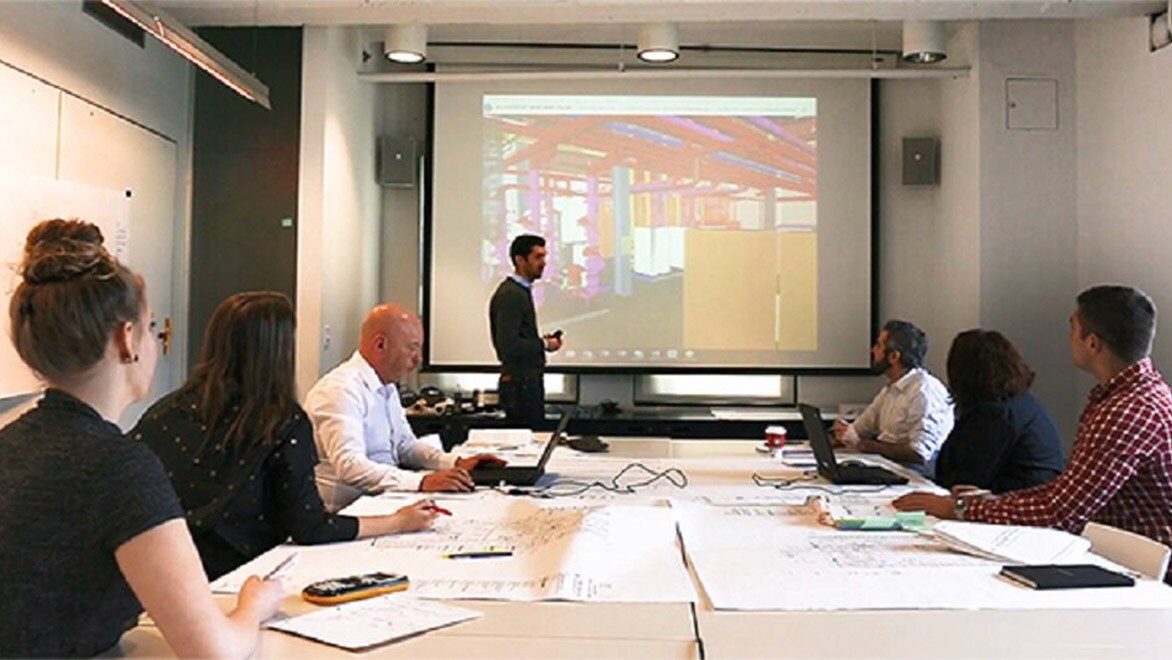BuroHappold Engineering saves big on Brown University IPD project
BIM 360 DESIGN AND BIM 360 GLUE CASE STUDY
Share this story
Cloud-based BIM collaboration gives BuroHappold a 20% time savings and a 90% cost reduction
Cloud-based BIM collaboration gives BuroHappold a 20% time savings and a 90% cost reduction
For its previous high-profile client, PNC Financial Services Group, BuroHappold Engineering (which worked on the project with architecture firm Gensler) wondered, “How do we engineer the greenest high-rise in the world?” And when BuroHappold was contracted to build the legendary Millennium Dome in London, the firm asked, “How do we create the largest dome-shaped tensile structure in the world?” BuroHappold team members have always asked the hard questions, pushing themselves to explore new strategies—and delivering progressive solutions that tackle new challenges.
When the firm took on the task of building the new Engineering Research Center for Brown University’s School of Engineering (designed by KieranTimberlake Architects), it looked to new technologies and strategies for project delivery. The 80,000-square-foot building was BuroHappold’s and Brown’s first integrated project delivery (IPD) project. The firm chose BIM 360 Design and BIM 360 to work efficiently with internal and external teams.
The American Institute of Architects (AIA) defines IPD as a project-delivery approach that integrates people, systems, business structures, and practices into a process that collaboratively harnesses the talents and insights of all participants. The goal is to optimize project results, increase value to the owner, reduce waste, and maximize efficiency through all phases of design, fabrication, and construction. That’s a loaded statement, so Paul McGilly, regional BIM leader for the US East Coast at BuroHappold, broke it down into simpler terms: “It’s about project teams coming together and working as a single team. It’s about sharing each other’s knowledge and skill sets and being able to deliver the project in a much better fashion in terms of time and cost.”
Choosing the right solution
BuroHappold looked at a variety of options and found that a lean software setup with BIM 360 could allow its colocated teams to collaborate on project models and files from multiple offices at a fraction of the cost of other solutions. “BIM 360 Design made sense once we costed it,” McGilly says. “It was a fraction of the cost of Panzura, for example . . . probably 10% of the cost.
“Teams can connect into the project models in BIM 360 Design and feel as if they’re actually working with us in the same office,” he adds. “And if we have any requests or design changes we want them to make, they can make them instantaneously.”
As a global practice, BuroHappold is able to use cloud-based BIM collaboration to tap into the skills of engineers in its offices around the world. For example, the firm can use highly specialized engineers in its Los Angeles–based offices for specialty work without spending thousands of dollars to colocate them in New York for months at a time.
Being able to share data seamlessly was a game changer for BuroHappold’s project team. Using the BIM 360 cloud platform made a huge difference in the work-life balance of the engineers, yielding a 20% time savings.
See how BuroHappold adopted BIM collaboration technology on Brown University’s Engineering Research Center. (video: 1:57 min)
“BIM 360 Design was a fraction of the cost of using Panzura, for example . . . probably 10% of the cost.”
—Paul McGilly, Regional BIM Leader, BuroHappold Engineering
Using design data further downstream
The firm was able to integrate model coordination and clash detection into its project workflow with BIM 360 Glue. Construction managers would coordinate the clash-resolution process by prioritizing clashes, then communicating to design engineers or trade partners what needed to be resolved and when. Trade partners used the BIM 360 Glue app on-site, making the build process more efficient.
“Using BIM 360 Glue, the designer and trade partner would receive clash reports from the construction managers, highlight issues in the model, send it back to the contractor, sit with the engineer or architect, and make design changes with the design engineer, who would then send it off to the contractor,” McGilly says. “It allowed us to walk right into the model and zoom into a problematic section, resolving conflicts as a team and analyzing the environment.”

Engineer Sean Ottomanelli leads a BIM-coordination meeting with Paul McGilly and others using BIM 360 Glue to walk through and resolve clashes in the model.
“Teams can connect into the project models in BIM 360 Design and feel as if they’re actually working with us in the same office. And if we have any requests or design changes we want them to make, they can make them instantaneously.”
—Paul McGilly, Regional BIM Leader, BuroHappold Engineering
The result
Almost 100 participants from the project’s architecture, engineering, and trade firms used BIM 360 during project ramp-up. Tight real-time coordination helped trade partners work closely with BuroHappold engineers on piping and ductwork systems that were especially complex, given the nature of the educational research facility. The ability to control and streamline coordination during design helped reduce the total number of change orders.
Overall, cloud-based BIM collaboration gave BuroHappold a time savings of 20% and a cost reduction of 90% on the Brown University IPD project. With this success, BuroHappold has made cloud-based BIM collaboration technology a core component of its design and detailing workflows. The firm now has seven projects on the BIM 360 platform. That could expand to 10 projects this year—and that’s only in the New York office. With offices in Europe now being introduced to BIM 360 Design, that number could easily double.

Brown University Engineering Research Center. Image courtesy of BuroHappold Engineering.
BIM 360 Design
Learn more about what BIM 360 Design can do for your company or download a free trial today.
